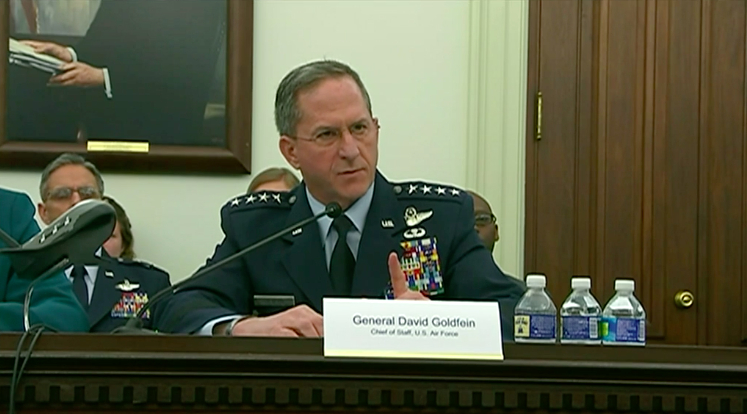
Air Force Chief of Staff Gen. David Goldfein speaks Wednesday at a House Appropriations Defense subcommittee hearing on USAF posture. Screenshot photo.
The Air Force will get 275 of its T-6 trainer aircraft back in the air this month, with the rest of the 444-plane fleet air worthy by this summer after an extended grounding after pilots reported hypoxia-like incidents during training flights, Air Force Chief of Staff Gen. David Goldfein said Wednesday.
Air Force engineers determined that three parts of the jet’s on board oxygen generating system were “failing at a much higher rate than anticipated,” Goldfein said during a House Appropriations Defense Subcommittee hearing. He did not specifically mention what those parts were, but Air Education and Training Command boss Lt. Gen. Steven Kwast told reporters last month there were issues with the aircraft’s “shutoff valve” and “with the reservoir,” which holds the oxygen.
AETC has since “put actions in place” to replace those parts quickly, said Goldfein.
The grounding has already had a significant impact. The Air Force has a goal to train 1,200 pilots this year as it works up to training 1,400 pilots per year in 2020 to address its shortage of about 2,000 total pilots, Goldfein said Wednesday. AETC will be about 200 short of the goal this year “primarily because of the T-6 grounding,” he said.
The stand down is the latest in a series of US military groundings because of hypoxia-like physiological incidents. The most notable of which, for the Air Force, was the 2011 grounding of the entire F-22 fleet. The Air Force not only learned lessons about investigating the issue and finding a root cause, the service also learned it should be more upfront with pilots and their families about the incident, Goldfein said.
During the F-22 grounding, the Air Force “lost communication with our families” who did not understand the issue and could have been scared for pilots, he said. For the T-6 grounding, the Air Force is addressing this “aggressively” and included pilots and their families “every step of the way” as it identified the problem and implemented fixes, he said.